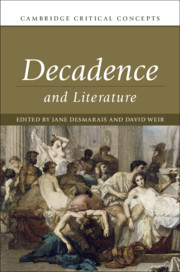Book contents
- Decadence and Literature
- Cambridge Critical Concepts
- Decadence and Literature
- Copyright page
- Dedication
- Contents
- Figures
- Contributors
- Acknowledgements
- Introduction
- Part I Origins
- Part II Developments
- Chapter 8 Decadence and the Visual Arts
- Chapter 9 Decadence and Music
- Chapter 10 Decadence, Parody, and New Women’s Writing
- Chapter 11 The Philosophy of Decadence
- Chapter 12 The Sexual Psychology of Decadence
- Chapter 13 The Theology of Decadence
- Chapter 14 The Science of Decadence
- Chapter 15 The Sociology of Decadence
- Part III Applications
- Select Bibliography
- Index
- References
Chapter 15 - The Sociology of Decadence
from Part II - Developments
Published online by Cambridge University Press: 12 August 2019
- Decadence and Literature
- Cambridge Critical Concepts
- Decadence and Literature
- Copyright page
- Dedication
- Contents
- Figures
- Contributors
- Acknowledgements
- Introduction
- Part I Origins
- Part II Developments
- Chapter 8 Decadence and the Visual Arts
- Chapter 9 Decadence and Music
- Chapter 10 Decadence, Parody, and New Women’s Writing
- Chapter 11 The Philosophy of Decadence
- Chapter 12 The Sexual Psychology of Decadence
- Chapter 13 The Theology of Decadence
- Chapter 14 The Science of Decadence
- Chapter 15 The Sociology of Decadence
- Part III Applications
- Select Bibliography
- Index
- References
Summary
In sociological terms, decadence serves as a classifier for categorizing pathological social conditions that catalyse ‘decline.’ While the term ‘decadence’ itself has not been explicitly used in much sociological scholarship, the structure of decadence has been deployed to situate related concepts like anomie and alienation in narratives of decline. With respect to artistic production, the ‘decadent role’ may be such that pathological attributes become accepted or expected to the point that they confer artistic legitimacy. Hence the decadent role becomes acceptable under a creative mandate; that is, individual artists may present the pathological features of social decline so long as they connect those decadent attributes to creative output. This sociological dynamic helps to explain why the work of certain nineteenth-century decadents ? such as Oscar Wilde ? is now held in high artistic regard. In the case of Wilde, his reputation as an artist has survived efforts to label him as pathological, so he has posthumously ‘lived up’ to the creative mandate his decadence entailed.
- Type
- Chapter
- Information
- Decadence and Literature , pp. 248 - 264Publisher: Cambridge University PressPrint publication year: 2019



